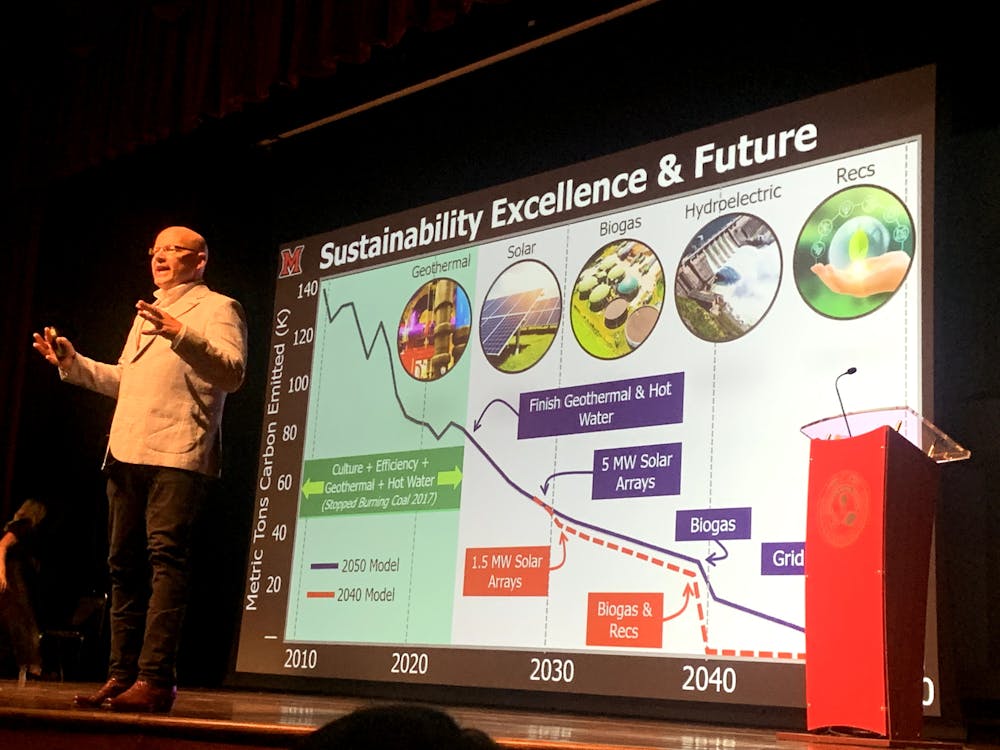An audience full of Miami University staff, faculty and students listened as President Greg Crawford presented during the most recent State of the University address on Tuesday, Oct. 4. Among the topics discussed were Miami’s sustainability initiatives and the updates to the Climate Action Plan.
“You can see what we've done is cut that sort of output of carbon on the metric tons by more than half,” said Crawford, pointing to a speculative graph of Miami’s carbon emissions through the year 2050. “So that's very exciting. But in the future, you look over predictions after the [present] and how do we get to carbon neutrality as an institution?”
Miami’s recent sustainability goals came to fruition in 2020 when President Crawford signed the Presidents' Climate Leadership Commitment (PCLC) and created the Climate Action Task Force. The primary goal of Miami since then has been achieving carbon neutrality, which finally has a date attached to it.
“Today, I'm proud to announce that Miami will go carbon neutral by the date of 2040,” Crawford said to a round of applause.
The goal of carbon neutrality by 2040 is sooner than the goal set by Miami’s energy provider, Duke Energy, which plans to go carbon neutral by 2050. The State of the University address was the first time this date was announced to the public.
Similarly, Oxford has its own climate action plan which is in the draft stage. The city’s current goal is to become carbon-neutral by 2045. Although Miami University and Oxford do not fall under the same plan, the draft claims that “the city and university work will work closely together to develop and implement climate action plans.”
“I do like the sustainability initiatives, I would hope that they would come a bit sooner because I saw the graph that the actual date for carbon neutrality is in 2040,” said Darek Sanabria Valderrama, a third-year diplomacy major who attended the address. “I would love to see it a bit sooner because I know we have the money for it.”
Miami has been transitioning off fossil fuels for the past 15 years, well before the PCLC or the creation of the Climate Action Task Force. These changes have come primarily via the transition off fossil fuel-powered steam energy and onto renewable sources.
“We are well on our way,” said Olivia Herron, director of sustainability. “We've been working towards reducing emissions since 2008, and we've reduced our greenhouse gas emissions 45% since [then].”
Miami categorizes its emissions into fuels burned on site, purchased electricity and indirect emissions such as student commuting. Within these sections, Miami plans to reduce its energy consumption while simultaneously converting to renewable energy sources, according to Miami’s director of sustainability Olivia Herron.
The Climate Action Task Force, of which Herron is a co-chair, has laid out steps to inform the wider Miami community about the Climate Action Plan, as well as the steps Miami will take to achieve its goal. The next step that Miami will take is digging geothermal walls to supply energy to North Campus. This project is planned to begin at the end of the fall semester.
The Climate Action Task Force submitted their plan to President Crawford on Sept. 25. After his approval, the details of the Climate Action Plan will be made available to the public, according to Herron. They hope to get feedback from students and faculty by presenting the first draft of the plan to anyone who wants to learn more about it.
Enjoy what you're reading?
Signup for our newsletter
“This whole semester is going to be adapting the plan and changing based on the feedback that we get,” Herron said.
However, the plan won’t be finalized until it’s approved by the Board of Trustees in February. Before that, it will be presented to ASG by the end of October and will have already gone through the Office of the President.
With all of the moving parts involved in Miami’s plan for carbon neutrality, student engagement and awareness are important to the Climate Action Task Force.
“We're doing it because the science tells us it's the right thing to do,” Herron said. “But also, we want it to be an opportunity for all of our students to learn about climate change and climate action.”




